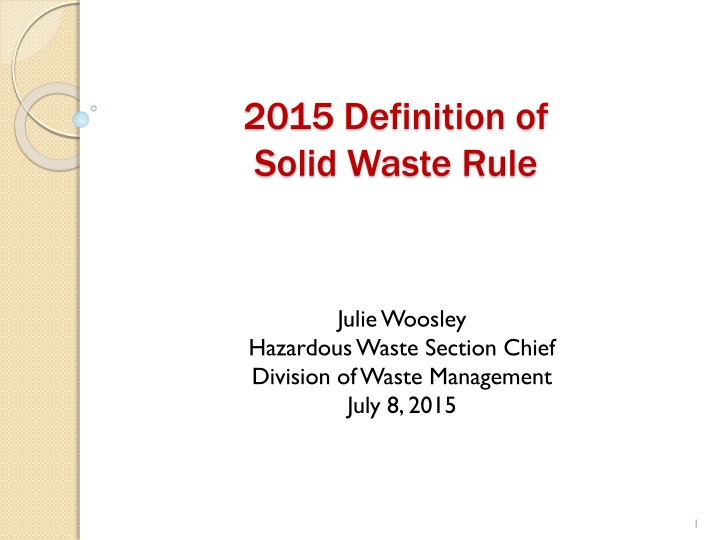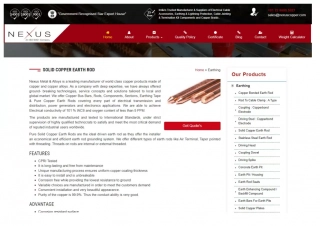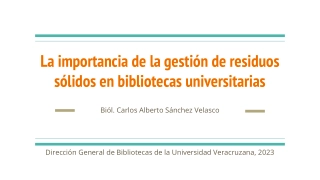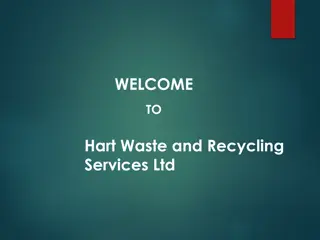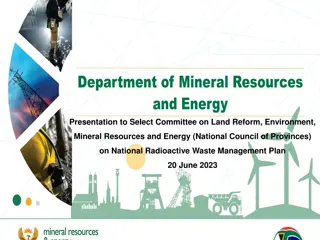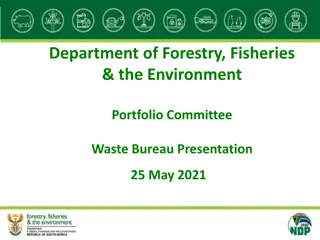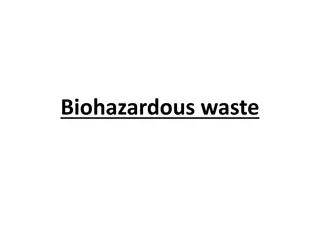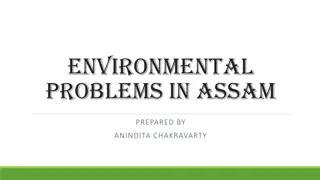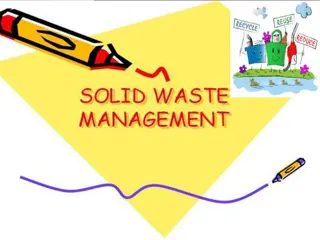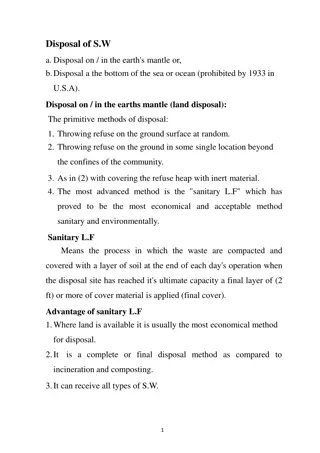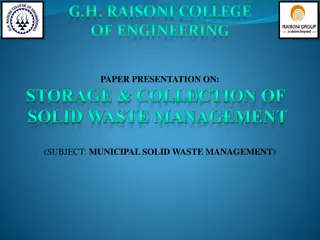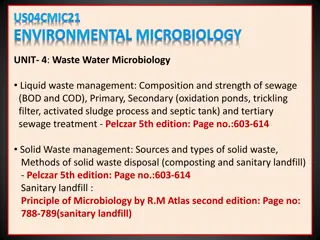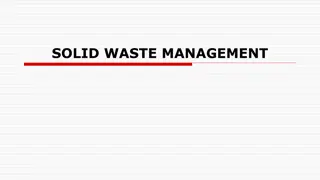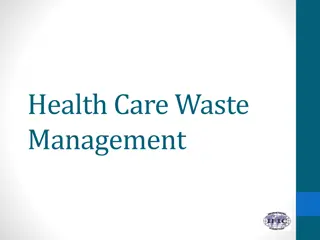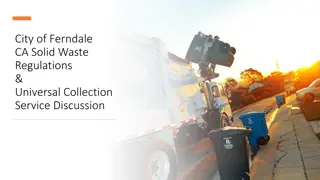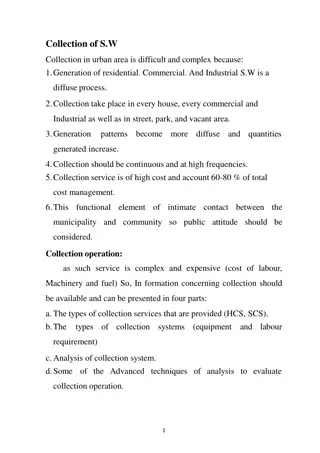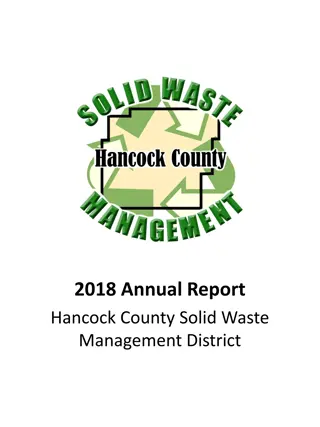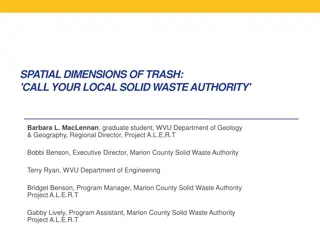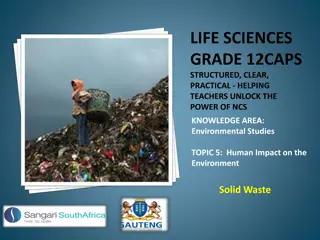Review of 2015 Definition of Solid Waste Rule
The review discusses how the 2015 Definition of Solid Waste Rule encourages recycling, increases environmental safeguards, and outlines the national economic impacts. It covers key changes such as exclusions for hazardous secondary materials and the verification process for recyclers. The rule aims to reduce compliance costs for industrial facilities and improve waste management practices. Detailed insights are provided on the potential impacts on regulated facilities in North Carolina.
Download Presentation

Please find below an Image/Link to download the presentation.
The content on the website is provided AS IS for your information and personal use only. It may not be sold, licensed, or shared on other websites without obtaining consent from the author.If you encounter any issues during the download, it is possible that the publisher has removed the file from their server.
You are allowed to download the files provided on this website for personal or commercial use, subject to the condition that they are used lawfully. All files are the property of their respective owners.
The content on the website is provided AS IS for your information and personal use only. It may not be sold, licensed, or shared on other websites without obtaining consent from the author.
E N D
Presentation Transcript
2015 Definition of Solid Waste Rule Julie Woosley Hazardous Waste Section Chief Division of Waste Management July 8, 2015 1
Review: The 2015 Definition of Solid Waste final rule encourages recycling by: Retaining the 2008 generator-controlled exclusion for hazardous secondary material recycled under the control of the generator (on- site, same company and toll manufacturing recycling). 1. Replacing the 2008 transfer-based exclusion with a new verified recycler exclusion where off-site transfers for recycling must go to RCRA-permitted recyclers or recyclers that have obtained a variance from the state or EPA. 2. Codifying new flexible approaches in the legitimacy definition for closed-loop recycling and commodity-grade recycled materials. 3. Finalizing a new remanufacturing exclusion for higher-value hazardous solvents which are remanufactured into commercial-grade products. 4. 2
Review: The 2015 DSW final rule increases environmental safeguards by: Codifying a new regulatory definition of the 2008 contained standard in order to prevent mismanagement of hazardous secondary materials during storage. 1. Replacing the 2008 exclusion for hazardous secondary materials transferred off-site with the verified recycler exclusion, increasing oversight by the state or EPA and thus preventing unpermitted facilities from receiving hazardous secondary material, unless they have obtained a variance from the state or EPA. 2. Codifying the sham recycling prohibition, requiring that all four legitimacy factors be met, and requiring legitimacy documentation when the recycled product has elevated levels of hazardous constituents. 3. Strengthening provisions related to variances and non-waste determinations, which are granted to facilities on a case-specific basis. 4. 3
Review: National Economic Impacts of 2015 DSW Final Rule Entities potentially affected by the 2015 DSW final rule include more than 5,000 industrial facilities in 634 industries (at the six-digit North American Industry Classification System (NAICS) code level) that generate or recycle hazardous secondary materials. The 2015 DSW rule is estimated to reduce compliance costs to the regulated community compared to Subtitle C hazardous waste regulation and compared to the 2008 DSW final rule. Adding a review process for requested variances for certified recyclers will be an additional cost to states. 4
Impacts to regulated NC facilities Potential for up to four facilities (out of ten) to no longer be classified as TSD (treatment, storage and disposal) facilities, which will result in a decrease in fees and RCRA program demands. Potential reduction of an estimated two out of 786 LQG and 90 out of 1782 SQG regulated facilities, which will result in a reduction of associated fees and RCRA program demands. Option to become a verified recycler could result in additional fee decreases. Potential impacts to recycling tax credits are negligible. 5
Impacts to the NC RCRA Program Reduction in annual generator and tonnage fees to support the program: -$109,000 (estimated). Increase of 1,134 hours/year (~0.5 FTE, $41,500/year) for new notifications, financial assurance, enforcement, verified recycler status, etc. Decrease of 1,135 hours/year (~0.5 FTE) in site inspections due to fewer TSDs, LQGs and SQGs, resulting in a smaller number of enforcement actions. Potential for additional spills/releases. $10,570 - $63,420 (estimated) cost to program per spill/release. 6
NC Rule Adoption NC did not adopt the 2008 rule due to concerns about several issues, including: legitimacy criteria; storage standards for containers/tanks; storage on the land; and lack of EPA/state oversight of recycling facilities. NC will be required to modify their program to adopt equivalent, consistent and no-less-stringent requirements. The 2015 rule appears to address NC s concerns with the 2008 rule except for one provision: Storage on the land is allowed (but must meet definition of contained ) The Hazardous Waste Section would like to add additional clarification to address this concern. 7
Definition of Contained Proposed Changes 260.10 Definitions * * * * * Contained means held in a unit (including a land-based unit as defined in this subpart) that meets the following criteria: The unit is in good condition, with no leaks or other continuing or intermittent unpermitted releases of the hazardous secondary materials or their hazardous constituents to the environment, and is designed, as appropriate for the hazardous secondary materials, to prevent releases of hazardous secondary materials to the environment. Unpermitted releases are releases that are not covered by a permit (such as a permit to discharge to water or air) and may include, but are not limited to, releases through surface transport by precipitation runoff, releases to soil and groundwater, windblown dust, fugitive air emissions, and catastrophic unit failures; The unit is properly labeled or otherwise has a system (such as a log) to immediately identify the hazardous secondary materials in the unit; and The unit holds hazardous secondary materials that are compatible with other hazardous secondary materials placed in the unit and is compatible with the materials used to construct the unit and addresses any potential risks of fires or explosions. Hazardous secondary materials in units that meet the applicable requirements of 40 CFR parts 264 or 265 are presumptively contained. (1) (2) (3) (4) 8
When Does NC Need to Adopt? Rule goes into effect when adopted by the state. State must adopt the three mandatory requirements by July 1, 2017. Will require rule-making to adopt provisions of the 2008 DSW rule that were not adopted by N.C. and to adopt the revisions of the Jan. 2015 rule. 9
Recent Issues Lawsuits filed by interest groups on both sides. Concerns in lawsuits not as specific as with 2008 Rule. Concerns: level of enforcement is too much or not enough. 10
GWWM Committee The Hazardous Waste Section recommends that the GWWM Committee recommend to the full EMC: Adoption of the full definition of solid waste rule, with one additional clarification as shown on slide eight. 11
Questions? Julie Woosley Hazardous Waste Section Chief 919-707-8203 Julie.woosley@ncdenr.gov 12
